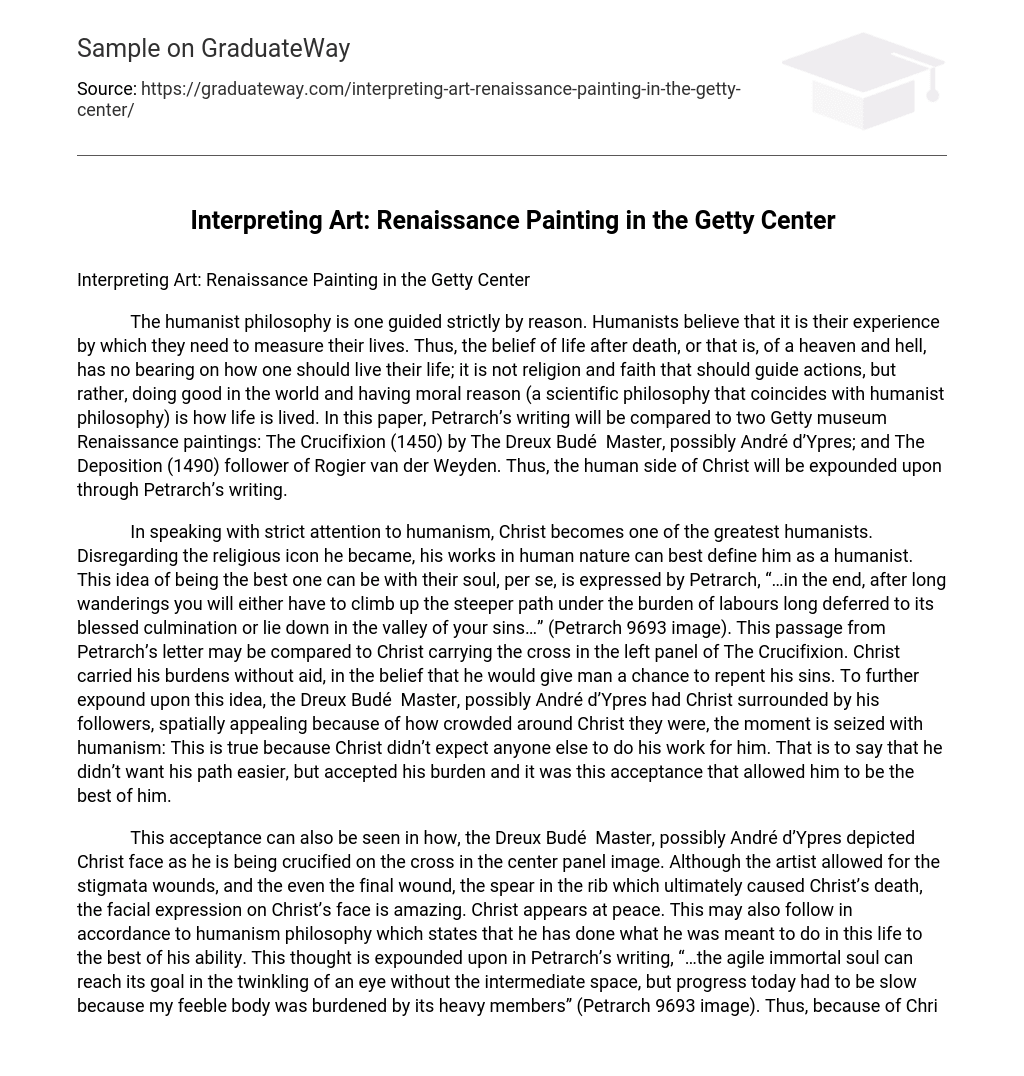The humanist philosophy is one guided strictly by reason. Humanists believe that it is their experience by which they need to measure their lives. Thus, the belief of life after death, or that is, of a heaven and hell, has no bearing on how one should live their life; it is not religion and faith that should guide actions, but rather, doing good in the world and having moral reason (a scientific philosophy that coincides with humanist philosophy) is how life is lived. In this paper, Petrarch’s writing will be compared to two Getty museum Renaissance paintings: The Crucifixion (1450) by The Dreux Budé Master, possibly André d’Ypres; and The Deposition (1490) follower of Rogier van der Weyden. Thus, the human side of Christ will be expounded upon through Petrarch’s writing.
In speaking with strict attention to humanism, Christ becomes one of the greatest humanists. Disregarding the religious icon he became, his works in human nature can best define him as a humanist. This idea of being the best one can be with their soul, per se, is expressed by Petrarch, “…in the end, after long wanderings you will either have to climb up the steeper path under the burden of labours long deferred to its blessed culmination or lie down in the valley of your sins…” (Petrarch 9693 image). This passage from Petrarch’s letter may be compared to Christ carrying the cross in the left panel of The Crucifixion. Christ carried his burdens without aid, in the belief that he would give man a chance to repent his sins. To further expound upon this idea, the Dreux Budé Master, possibly André d’Ypres had Christ surrounded by his followers, spatially appealing because of how crowded around Christ they were, the moment is seized with humanism: This is true because Christ didn’t expect anyone else to do his work for him. That is to say that he didn’t want his path easier, but accepted his burden and it was this acceptance that allowed him to be the best of him.
This acceptance can also be seen in how, the Dreux Budé Master, possibly André d’Ypres depicted Christ face as he is being crucified on the cross in the center panel image. Although the artist allowed for the stigmata wounds, and the even the final wound, the spear in the rib which ultimately caused Christ’s death, the facial expression on Christ’s face is amazing. Christ appears at peace. This may also follow in accordance to humanism philosophy which states that he has done what he was meant to do in this life to the best of his ability. This thought is expounded upon in Petrarch’s writing, “…the agile immortal soul can reach its goal in the twinkling of an eye without the intermediate space, but progress today had to be slow because my feeble body was burdened by its heavy members” (Petrarch 9693 image). Thus, because of Christ’s bodily effort in achieving his life’s goal, to relieve men of forever being burdened by their sins, he is finally at peace.
The same physiognomy is witnessed in The Deposition by follower of Rogier van der Weyden. Although Christ’s face is in the shadows (symbolizing death) all around him is light. This very Renaissance technique of using light which symbolizes God, faith, etc. and it is the golden background which gives emphasis to the drama of the moment. The humanity of the expressions of Christ’s followers which surround him in death (just as they surrounded him in life and in The Crucifixion while Christ was carrying the cross) is what is strongly felt in the painting. It is the followers’ looks that coincide with Petrarch’s statement, “How earnestly should we strive to trample beneath our feet not mountain-tops but the appetites which spring from earthly impulses” (Petrarch 9696). This statement means, in relevance to Christ’s sacrifice and the fulfillment of his purpose on earth, in humanistic terms, then how can his followers make such a sacrifice worth it? The answer, as how Petrarch explains it, is simple; they must do the best they can in this world, which is the main theme of humanism.
Works Cited
Petrarch. Petrarch’s Letter: The Ascent of Mount Ventoux to Dionisio da Borgo San Sepolcro.





